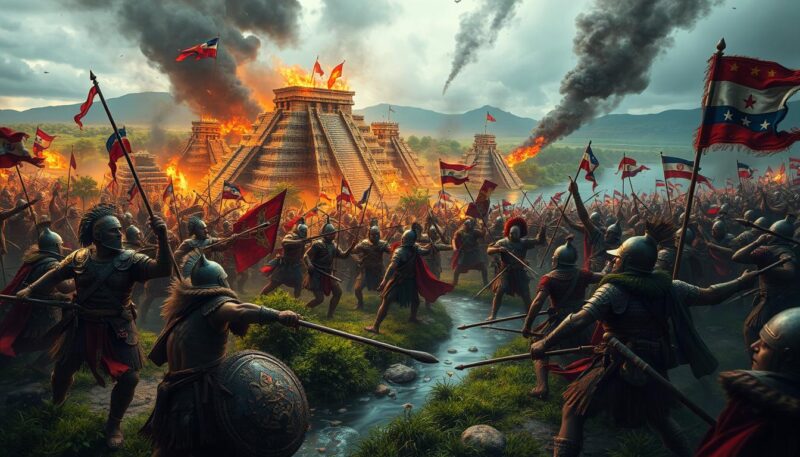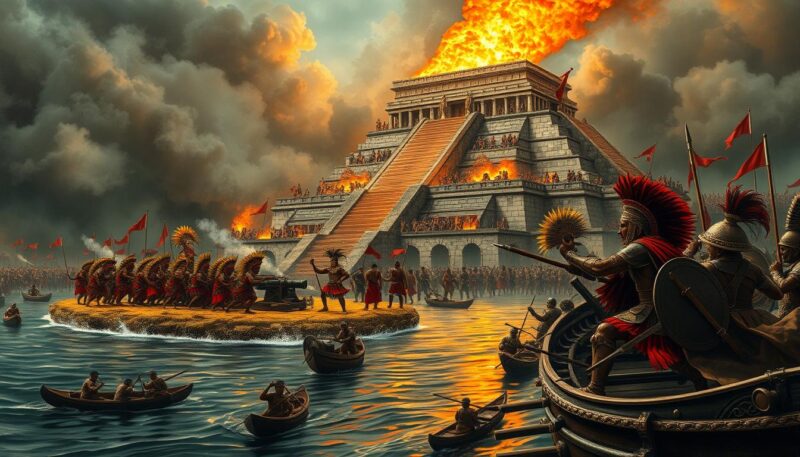The fall of Tenochtitlán, which took place from May 22 to August 13, 1521, represents a decisive moment in global history, one that not only marked the end of the Aztec Empire but also set the stage for Spain’s imperial expansion in the Americas. This brutal siege, orchestrated by the relentless Hernán Cortés, culminated after 93 harrowing days and involved a staggering loss of life. As estimated, tens of thousands perished amidst the chaos, revealing just how deadly the Spanish siege of Tenochtitlán truly was. The impact of this military confrontation — characterized by intense battles and strategic alliances with Indigenous tribes like the Tlaxcalans — significantly reshaped the cultural and political landscape of Mesoamerica. It was not just a conquest; it was a demonstration of the devastating consequences that would follow in the wake of the Hernán Cortés conquest, transforming the course of history forever.
Overview of the Fall of Tenochtitlán
The fall of Tenochtitlán on August 13, 1521, marked a significant turning point in the history of the Aztec Empire. The extensive territorial control, highlighted by a population of approximately 11 million, faced mounting pressures from within and external threats as Hernán Cortés and his forces shifted the dynamics of power in the region. As alliances were forged with local tribes, the stage was set for the inevitable confrontation that would lead to the collapse of Aztec resistance.
Context of the Siege
The Aztec Empire, known for its complexity and vast reach, found itself vulnerable to social and political tensions among its subject states. With monarchical authority resting on the shoulders of Montezuma II, the initial diplomatic efforts began to unravel as discontent brewed among tribes compelled to pay hefty tributes. The arrival of Hernán Cortés in 1519 catalyzed an upheaval. His military strategies allowed him to align with the Tlaxcalans and other disgruntled groups, drawing them into the conflict against the Aztecs. Montezuma’s death not only symbolized the fall of leadership but also underscored the collapse of Aztec stability as chaos ensued in the wake of the siege.
The Geography and Structure of Tenochtitlán
The geography of Tenochtitlán played a crucial role in its defense and eventual downfall. Surrounded by lakes and built on an island, the city was an engineering marvel with canals and causeways providing access and movement. The Aztecs utilized these features to their advantage, relying on approximately 400 war canoes to protect their territory. Despite this natural fortification, Hernán Cortés adapted his military strategies to exploit vulnerabilities, deploying field guns and brigantines to project firepower onto the Aztec defenses.
The siege escalated in intensity, especially with the settlement of smallpox and the Aztecs, which decimated the population during the critical months leading to the final assault. Though the Aztecs possessed a numerical advantage with approximately 80,000 warriors, the effective Spanish combat strategies, combined with the widespread disease, contributed significantly to the catastrophic consequences faced by the defenders.
| Statistics | Data |
|---|---|
| Date of Fall | August 13, 1521 |
| Aztic Population | 11 million |
| Tenochtitlán Population | 200,000 |
| Cortés Initial Force | 500 men |
| Cortés Force during Siege | 900-1,300 infantry, 90-100 cavalry |
| Estimated Tlaxcalan Allies | 100,000 |
| Estimated Total Aztec Casualties | 100,000-240,000 |
| Casualties among Spanish Forces | 450-860 killed |
The Brutal Siege That Changed History
The Siege of Tenochtitlán stands as a poignant chapter in history, primarily marked by the contrasting military dynamics of the Spanish vs Aztecs. With a small yet determined force, Hernán Cortés launched a meticulously planned assault against a well-fortified city under the rule of the Cuauhtémoc last emperor. The ensuing conflict not only demonstrated innovative military tactics but also highlighted the profound impact of disease on the Aztec civilization.
Military Strategies and Tactics
During the 75-day siege, Hernán Cortés employed a range of military strategies designed to exploit the vulnerabilities of the Aztecs. Despite facing an estimated 200,000 defenders, the Spanish utilized their naval vessels to encircle Tenochtitlán and launched coordinated attacks from both land and water. Cortés’s forces revolutionized siege warfare with superior weaponry, notably cannons and gunpowder, engaging in a sustained effort to isolate the Aztec defenders by cutting off their critical food and water supplies. This strategic maneuvering was bolstered by alliances with disaffected Indigenous groups, who played a crucial role in tipping the scales of power during the conflict.
The Role of Disease in the Siege
The impact of smallpox on the Aztecs proved devastating amid the siege. With estimates indicating an 80% mortality rate due to disease and starvation, the Aztec population continued to dwindle rapidly. This introduced a significant imbalance in the ability of the remaining warriors to mount an effective defense against the Spanish advances. The spread of smallpox coincided with the warfare, striking at the heart of the Aztec Empire during its most vulnerable moment. As the siege progressed, the weakening of the Aztec forces became increasingly evident, leading to a critical shift in power dynamics that ultimately resulted in the fall of Tenochtitlán.

| Factor | Details |
|---|---|
| Duration of Siege | Approximately 75 days (May 1521 – August 1521) |
| Population Impact | Over 80% mortality rate among the Aztec population due to disease |
| Military Strength | Spanish: ~900 soldiers; Aztecs: ~200,000 defenders |
| Allied Forces | Indigenous allies including Tlaxcalans |
| Key Aspects | Cortés’s innovative tactics, naval assaults, disease impact |
Conclusion
The fall of Tenochtitlán on August 13, 1521, was not merely a military defeat but a pivotal event that altered the course of history and marked the end of the Aztec Empire. This dramatic siege resulted in the loss of countless lives and the decimation of a thriving civilization with a population exceeding 200,000 at its zenith. The significance of Aztec history has been profoundly shaped by the brutality of the siege, where factors such as disease played a crucial role, wiping out nearly half of Tenochtitlán’s inhabitants through smallpox. This tragic scenario illustrates the steep human and cultural costs associated with the Spanish conquest.
The legacy of the conquest is multi-dimensional, reflecting the complex interplay between Indigenous suffering and the onset of European dominance. It ushered in an era of profound transformation in Mexico’s colonial era, whose effects are still visible in contemporary discussions about identity and cultural heritage. The stunning architecture of Tenochtitlán, including its temples and markets, speaks to a sophisticated society that once thrived, highlighting what was lost in the aftermath of Spanish colonization.
As we reflect on this monumental episode, it is essential to acknowledge the ongoing dialogue about the implications of colonization and Indigenous resilience. The memory of Tenochtitlán serves as a powerful symbol in the narrative of resistance against oppression, reminding us of the historical injustices that shape modern Mexico. In examining the fall of Tenochtitlán and its aftermath, one gains a deeper understanding of the challenges faced by Indigenous cultures in preserving their identities amidst the forces of colonization.

